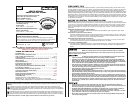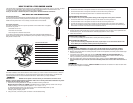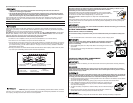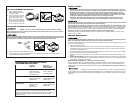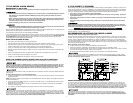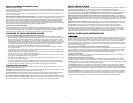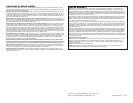
5
IF THIS SMOKE ALARM SOUNDS
RESPONDING TO AN ALARM
During an alarm, you will hear a loud, repeating horn pattern: 3 beeps, pause, 3 beeps, pause.
•
If the unit alarms and you are not testing the unit, it is warning you of a potentially dangerous situation
that requires your immediate attention. NEVER ignore any alarm. Ignoring the alarm may result in
injury or death.
• Never disconnect the AC power to quiet an unwanted alarm. Disconnecting the power disables the
Alarm so it cannot sense smoke. This will remove your protection. Instead, open a window or fan
the smoke away from the unit. The Alarm will reset automatically.
• If the unit alarms get everyone out of the house immediately.
•
ELECTRICAL SHOCK HAZARD: Attempting to disconnect the power connector from the unit when the
power is on may result in electrical shock, serious injury or death.
When an interconnected system of AC powered units is in alarm, the alarm indicator light on the unit(s) that initi-
ated the alarm will blink rapidly. It will remain OFF on any remaining units.
If the unit alarms, get everyone out of the dwelling immediately.
If the unit alarms and you are certain that the source of smoke is not a fire—cooking smoke or an extremely dusty
furnace, for example—open a nearby window or
door and fan the smoke away from the unit (Models SA4121B
and 4120SB Only: use the Silence Feature to silence the Alarm). This will silence the alarm, and once the
smoke clears the unit will reset itself automatically.
WHAT TO DO IN CASE OF FIRE
• Don’t panic; stay calm. Follow your family escape plan.
• Get out of the house as quickly as possible. Don’t stop to get dressed or collect anything.
• Feel doors with the back of your hand before opening them. If a door is cool, open it slowly. Don’t open a
hot door. Keep doors and windows closed, unless you must escape through them.
• Cover your nose and mouth with a cloth (preferably damp). Take short, shallow breaths.
• Meet at your planned meeting place outside your home, and do a head count to make sure everybody got
out safely.
• Call the Fire Department as soon as possible from outside. Give your address, then your name.
• Never go back inside a burning building for any reason.
• Contact your Fire Department for ideas on making your home safer.
USING THE SILENCE FEATURE (MODELS SA4121B AND 4120SB ONLY)
The Silence Feature on these units can temporarily quiet an unwanted alarm for up to 15 minutes.
The Silence Feature does not disable the unit—it makes it temporarily less sensitive to smoke. For your
safety, if smoke around the unit is dense enough to suggest a potentially dangerous situation, the unit
will stay in alarm or may re-alarm quickly. If you do not know the source of the smoke, do not assume it
is an unwanted alarm. Not responding to an alarm can result in property loss, injury, or death.
While the unit is in the “silence mode,” the test button will not operate. The Alarm cannot be tested while in the
silence mode.
To silence Smoke Alarms in an interconnected series:
1. To silence multiple alarms in an interconnected series, you must press the silence button on the unit(s) that
triggered the alarm.
NOTE: The red light under the silence button on the initiating alarm will flash rapidly. The red light will be off on
all other Smoke Alarms.
2. Once you activate the Silence feature, you will hear a reminder “chirp” on the initiating alarm about once a
minute (for up to 15 minutes).
3. While the units are in the “silence mode,” the test buttons will not operate. The alarms cannot be tested
while in the silence mode.
4. The “chirping” on the initiating alarm will stop once the unit returns to normal operation.
The Silence Feature on these units can temporarily quiet an unwanted alarm for up to 15 minutes. To use this
feature, press the “Push to Silence” button on the cover. Once you activate it, you will hear a reminder “chirp”
about once a minute (for up to 15 minutes) and the Test feature is temporarily disabled. The “chirping” will stop
once the unit returns to normal operation.
If the unit will not silence and no heavy smoke is present, or if it
stays in silence mode continuously, it should be replaced immediately.
IF YOU SUSPECT A PROBLEM
Smoke Alarms may not operate properly because of dead, missing or weak batteries, a build-up of dirt, dust or
grease on the Smoke Alarm cover, or installation in an improper location. Clean the Smoke Alarm as described
in “Regular Maintenance,” and install a fresh battery, then test the Smoke Alarm again. If it fails to test properly
when you use the test button, or if the problem persists, replace the Smoke Alarm immediately.
• If you hear a “chirp” once a minute, replace the battery.
• If you experience frequent non-emergency alarms (like those caused by cooking smoke), try relocat-
ing the Smoke Alarm.
• If the alarm sounds when no smoke is visible, try cleaning or relocating the Smoke Alarm. The cover
may be dirty.
• If the alarm does not sound during testing, make sure it is receiving AC power from the household
current.
Always discharge the branch circuit before servicing an AC or AC/DC Smoke Alarm. First, turn off the AC
power at the circuit breaker or fuse box. Next, remove the battery from Smoke Alarms with battery back-up.
Finally, press and hold the test button for 5-10 seconds to discharge the branch circuit.
If the Smoke Alarm is still not operating properly, and it is still under warranty, please see “How to Obtain
Warranty Service” in the Limited Warranty.
Do not try fixing the alarm yourself – this will void your warranty!
RECOMMENDED LOCATIONS FOR SMOKE ALARMS
Installing Smoke Alarms in Single-Family Residences
The National Fire Protection Association (NFPA), recommends one Smoke Alarm on every floor, in every sleep-
ing area, and in every bedroom. In new construction, the Smoke Alarms must be AC powered and interconnect-
ed. See “Agency Placement Recommendations” for details. For additional coverage, it is recommended that
you install a Smoke Alarm in all rooms, halls, storage areas, finished attics, and basements, where temperatures
normally remain between 40˚F (4˚C) and 100˚F (38˚C). Make sure no door or other obstruction could keep smoke
from reaching the Smoke Alarms.
More specifically, install Smoke Alarms:
• On every level of your home, including finished attics and basements.
• Inside every bedroom, especially if people sleep with the door partly or completely closed.
• In the hall near every sleeping area. If your home has multiple sleeping areas, install a unit in each. If a hall is
more than 40 feet long (12 meters), install a unit at each end.
• At the top of the first-to-second floor stairway, and at the bottom of the basement stairway.
Specific requirements for Smoke Alarm installation vary from state to state and from region to region. Check
with your local Fire Department for current requirements in your area.
It is recommended AC or AC/DC units
be interconnected for added protection.
INSTALLING SMOKE ALARMS IN MOBILE HOMES & RVS
For minimum security install one Smoke Alarm as close to each sleeping area as possible. For more security, put
one unit in each room. Many older mobile homes (especially those built before 1978) have little or no insulation. If
your mobile home is not well insulated, or if you are unsure of the amount of insulation, it is important to install units
on inside walls only. Smoke Alarms should be installed where temperatures normally remain between 40˚F (4˚C) and
100˚F (38˚C).
WARNING: Test units used in RVs after the vehicle has been in storage, before every trip, and
once a week while in use. Failure to test units used in RVs as described may remove your protection.
This equipment should be installed in accordance with NFPA (National Fire Protection Association) 72 and
101.
National Fire Protection Association, One Batterymarch Park, Quincy, MA 02269-9101. Additional local building
and regulatory codes may apply in your area. Always check compliance requirements before beginning any
installation.



